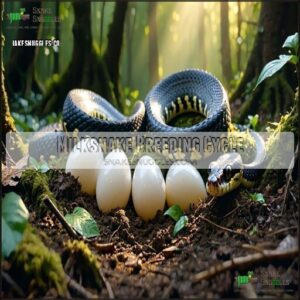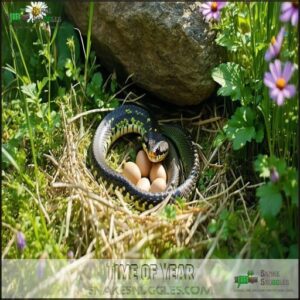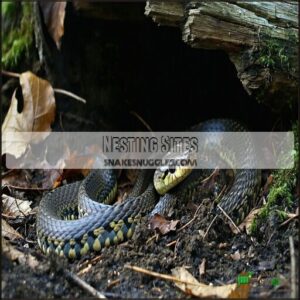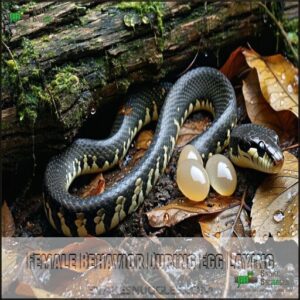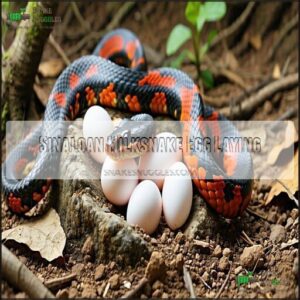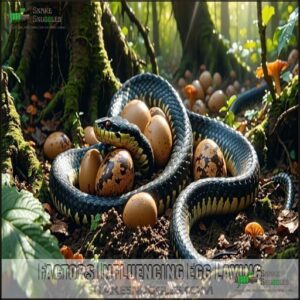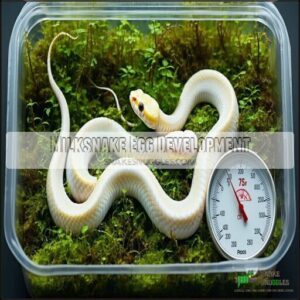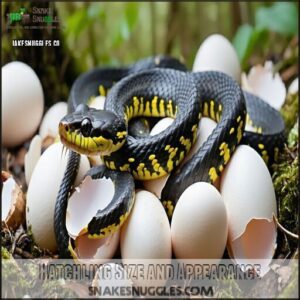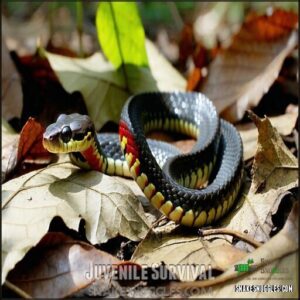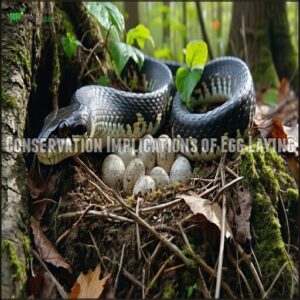This site is supported by our readers. We may earn a commission, at no cost to you, if you purchase through links.

A female milk snake will deposit 3-17 eggs in rotting logs, compost piles, or under rocks where conditions stay warm and moist.
She doesn’t stick around to care for them – once laid, the eggs are on their own for the 6-8 week incubation period.
Temperature determines both development speed and the sex ratio of hatchlings.
Knowing these egg-laying patterns helps explain why you might spot more milk snakes during their active breeding season.
Table Of Contents
- Key Takeaways
- Milksnake Breeding Cycle
- Eastern Milksnake Egg Laying
- Sinaloan Milksnake Egg Laying
- Factors Influencing Egg Laying
- Milksnake Egg Development
- Milksnake Hatching and Juvenile Development
- Conservation Implications of Egg Laying
- Frequently Asked Questions (FAQs)
- When do milk snakes lay their eggs?
- How long does it take for milk snakes to hatch?
- When do milk snakes mate?
- How long do milk snakes incubate?
- Are all milk snake eggs fertile?
- How many eggs does a snake lay?
- Where do milk snakes nest?
- How often does a milk snake lay eggs?
- How many milk snakes are in a litter?
- Are milk snakes good to have around?
- Conclusion
Key Takeaways
- You’ll find milk snakes laying eggs from May to July, shortly after they emerge from hibernation in the spring.
- Your female milk snake will deposit 3-17 eggs in hidden, moist locations like rotting logs, compost piles, or under rocks, then abandon them without providing parental care.
- You’ll need to wait 6-8 weeks for the eggs to incubate, with temperature influencing both development speed and the sex ratio of hatchlings.
- You can identify milk snake eggs by their soft, leathery texture and pearly white color, measuring about 1 to 1.5 inches long.
Milksnake Breeding Cycle
Milk snakes follow a predictable breeding cycle that begins in spring, shortly after emerging from hibernation.
During this time, males actively seek mates, and females prepare for egg-laying in the warmer months.
Mating Season
Spring marks the start of the milk snake breeding season, packed with fascinating courtship rituals.
Males compete fiercely to impress females, ensuring only the strongest pass on their genes. Females guide the process, leaving pheromone trails to attract suitors.
A vital aspect involves temperature and humidity control for breeding success.
- Male competition: Head nudges, tongue flicks, and body jerks.
- Pheromone trails: Females signal readiness.
- Mating dens: Some snakes mate before leaving winter shelters.
Egg Incubation Period
The snake egg incubation period, lasting 6-8 weeks, is vital for milk snake eggs.
Success hinges on maintaining ideal conditions:
- Temperature Effects: Keep 82-85°F for proper embryo growth.
- Humidity Control: Aim for 80-85% to prevent drying or rotting.
- Incubation Substrates: Use vermiculite or perlite for moisture balance.
Monitor these factors closely to guarantee a smooth hatching timeline without common problems.
Clutch Size
Milk snake reproduction brings plenty of surprises, especially with their clutch size.
A typical snake egg clutch size varies from 4 to 16 eggs, though the average clutch is around 10.
Female size plays a big role—larger females lay more eggs.
Geographic differences and food availability also influence egg variation.
Some females may even lay a second clutch within weeks.
These adaptable snakes guarantee their milk snake eggs thrive, using clever strategies to maximize survival.
Hibernation and Post-Hibernation Behavior
Milk snakes emerge from brumation in spring, driven by warmer temperatures and the need to replenish energy reserves. After months of dormancy, their first goal is a hearty post-hibernation diet to fuel mating readiness.
You’ll often see them basking to warm up or hunting small prey to rebuild strength. Their movements become more active, signaling the start of the snake mating season.
- Quick bursts of activity after long rest
- Hunger-driven hunts for small rodents
- Basking to regulate body temperature
- Heightened awareness to evade predators
- Renewed energy for courtship behaviors
Brumation effects fade as these snakes prepare for reproduction.
Reproductive Strategies
Milk snake reproduction kicks off with courtship rituals, where males use pheromone trails to locate receptive females.
These displays, including coiling and tactile moves, boost reproductive success. Females can store sperm, allowing flexibility in snake egg laying patterns.
Multiple clutches are possible within a season, ensuring adaptability.
Egg laying aligns with environmental cues, optimizing the snake reproductive cycle for survival and healthy hatchlings.
Eastern Milksnake Egg Laying
Eastern milk snakes lay their eggs in late spring or early summer, typically choosing hidden, moist locations to protect them.
These eggs, soft and leathery, range from 4 to 25 per clutch, depending on the size of the female.
The eggs are laid in a way that they are protected.
Time of Year
Milk snake egg laying follows seasonal variation, with Eastern milk snakes laying eggs during early summer, typically mid-June to July.
Annual cycles align with warming temperatures and rising humidity, ensuring ideal conditions for incubation. Climate impact can shift this timing slightly.
Here’s what influences snake egg laying months:
- Regional differences in temperature.
- Availability of moist nesting spots.
- Daylight length changes.
- Post-hibernation energy levels.
- Consistent seasonal patterns.
The factors influencing egg laying are closely tied to the snake’s environment and biological rhythms, ensuring that the eggs are laid under optimal conditions for incubation and survival.
Nesting Sites
Eastern milk snakes are scrupulous in regards to snake egg laying, choosing concealed locations with ideal moisture levels and site security.
Their location preferences include warm, humid spots that offer protection and proper nesting materials.
- Stone walls or rock crevices for natural shelter.
- Rotting logs or piles of decaying leaves for moisture retention.
- Loose soil or sandy areas for easy egg laying.
- Abandoned burrows left by mammals.
- Dense vegetation cover for camouflage.
These nesting sites guarantee the eggs are safe, hidden, and in conditions that support healthy development.
For controlled environments, consider using a specialized egg container.
Female Behavior During Egg Laying
When it’s time for egg laying, female milk snakes carefully choose hidden, moist egg laying sites like rotting logs or burrows.
They focus on nest selection to guarantee survival, placing their clutch of 4-16 eggs in secure locations.
With no maternal investment after laying, their post-laying behavior includes camouflaging or minimal guarding before leaving.
This strategic clutch placement maximizes hatchling success.
- Key behaviors:
- Seeks moist, hidden spots.
- Lays eggs 30 days post-ovulation.
- Uses ovulation pheromones for timing.
- Guarantees proper temperature and humidity.
- Leaves eggs unattended.
Male Role in Egg Laying
Male milk snakes play their part in reproduction through courtship rituals like body movements and scent marking.
They follow pheromone trails left by females, initiating mating behavior. Fertility enhancement comes from prolonged copulation.
However, their role ends after mating. Males contribute nothing to egg laying or tending snake egg laying sites, leaving milk snake eggs entirely under female care, emphasizing their “hands-off” approach to milk snake reproduction, which involves prolonged copulation for fertility enhancement.
Egg Characteristics
Eastern milksnake eggs are like nature’s tiny treasure boxes, holding life within delicate shells.
Their egg size is about 1 to 1.5 inches long.
The egg color is a pearly white, resembling frosted glass.
The egg texture is soft, leathery, and flexible.
- Shape: Elongated and oblong, not perfectly round.
- Shell Porosity: Allows moisture exchange for embryonic growth.
- Clutch Variation: Ranges from 4-25 eggs.
Sinaloan Milksnake Egg Laying
While Eastern milk snakes have their distinct reproductive patterns, Sinaloan milk snakes follow their own timeline.
While Eastern milk snakes follow their own rhythm, Sinaloan milk snakes dance to a different seasonal beat.
These vibrantly banded reptiles typically breed from May to June, with females producing 4-16 eggs per clutch.
After mating, a female will seek out warm, humid spots under rocks or in crevices for her nesting locations.
Milk snakes often produce one to two clutches annually, depending on environmental factors.
Aspect Details
Females may produce a second clutch just 44 days after their first laying season.
Factors Influencing Egg Laying
You’ll find that several key factors affect when milk snakes lay their eggs, including temperature, humidity, food availability, and habitat quality.
Your milk snake will typically delay egg-laying if conditions aren’t ideal, as they need proper resources to produce healthy clutches.
Environmental Factors
Environmental factors profoundly influence when and how milk snakes lay eggs.
These reptiles require specific conditions for successful reproduction.
Temperature impact directly affects egg development, while proper humidity needs (70-80%) prevent drying or rotting.
Habitat degradation increasingly threatens natural nesting sites.
- Consistent temperatures between 80-85°F optimize incubation temperature and embryo development
- Humidity levels must maintain 70-80% throughout the laying period
- Climate effects can disrupt normal egg-laying cycles by several weeks
- Pollution exposure may compromise egg shell integrity and hatchling health
Female milk snakes carefully select protected, moist locations that shield eggs from environmental extremes, which is crucial for successful embryo development and to prevent habitat degradation.
They also need to maintain proper humidity needs and avoid pollution exposure to ensure the health of their hatchlings.
Food Availability
Beyond temperature and humidity, food availability directly impacts when milk snakes lay eggs.
Females with access to plentiful prey can develop healthier, more numerous eggs.
When rodents, lizards, and small birds are scarce, egg production often slows or decreases in quality.
Predator Presence
Predator presence substantially influences where and when milk snakes lay their eggs.
These reptiles carefully select hidden nesting sites—under rocks, inside rotting logs, or within abandoned rodent burrows—to protect their clutches from nest predation.
Their defensive behaviors include laying eggs in areas with minimal scent trails and choosing locations that offer quick escape routes, directly impacting hatchling survival rates in the wild, which is crucial for their wild survival.
Habitat Quality
Habitat quality plays a vital role in milk snake egg laying success.
These selective reptiles require specific nesting sites with:
- Appropriate nesting locations (rotting logs, loose soil, or rock crevices)
- Ideal moisture levels (not too wet or dry)
- Proper soil composition for egg development
- Adequate vegetation cover for protection
Areas with balanced environmental factors and low predator abundance create ideal conditions for female milk snakes to deposit and successfully incubate their eggs, which is crucial for their egg development.
Climate Change
Climate change disrupts milk snakes’ reproductive patterns.
Rising temperatures alter egg-laying cycles, forcing habitat shifts as snakes seek suitable nesting sites.
Environmental factors like decreased rainfall affect humidity requirements essential for proper egg development.
Temperature fluctuations can speed up or slow down incubation, threatening genetic diversity.
Conservation strategies now focus on protecting diverse habitats to reduce extinction risks as these sensitive reptiles face unprecedented environmental challenges.
Milksnake Egg Development
You’ll find milk snake eggs developing from simple cells into fully formed baby snakes over a 6-8 week period.
During this time, the eggs need consistent temperatures between 80-85°F and humidity levels of 70-80% for the embryos to grow properly.
Embryonic Development
Milk snake embryonic development follows a fascinating biological timeline inside each egg.
The journey from cell cluster to baby snake involves complex changes over 6-8 weeks.
- Cell division begins immediately after eggs are laid, creating the foundation for all body systems
- Tissue formation establishes essential organs and muscle structures during early weeks
- Growth leaps occur at regular intervals, with rapid development of scales and internal systems
- Egg formation continues as embryos consume nutrients from the yolk
- Developmental stages progress steadily until hatching approaches
Proper incubation needs humidity for successful hatching.
Incubation Temperature
While embryos develop, temperature becomes their lifeline. The ideal range for milk snake eggs sits between 80-85°F, with reptile egg temperature control being critical for success.
Your incubation temperature plan should include:
- Using digital thermometers with remote sensing probes
- Creating a temperature gradient with a 85-90°F basking area
- Monitoring for temperature fluctuations that could harm development
- Understanding that warmer temperatures produce males due to sex determination
For best results, consider using a reptile egg incubator. Like nature’s thermostat, steady warmth guarantees hatching success and healthy hatchlings.
Humidity Requirements
During incubation, maintaining ideal humidity is vital for milk snake eggs. Keep levels between 80-85% to guarantee proper moisture balance without wetting the shells directly.
Vermiculite or perlite make excellent incubation substrates as they retain moisture effectively. Monitor humidity daily using a reliable hygrometer, as fluctuations can reduce hatching success.
A milksnake egg hygrometer can help with this. Place a small water dish near (not touching) the eggs to maintain consistent levels.
Regional variations exist—eggs from desert milk snake subspecies may tolerate slightly lower humidity than tropical varieties. Avoid misting eggs directly; instead, dampen the substrate when needed.
Regular ventilation prevents harmful carbon dioxide buildup while preserving necessary moisture levels.
Developmental Stages
With proper humidity in place, the developmental stages inside milk snake eggs unfold in remarkable sequence.
The journey begins with rapid cellular division, creating the foundation for life.
During these critical weeks, watch for:
- Tissue formation as organs develop and scales begin to form
- Growth leaps where embryos nearly double in size
- Development of distinctive color patterns that will later help identify subspecies
Each developmental milestone brings the tiny snakes closer to their eventual emergence, transforming from simple cells into fully-formed hatchlings ready for independence.
Hatching Process
From cellular development to visible snake, the hatching process marks the final journey of milk snake eggs.
As incubation ends, you’ll notice several exciting changes.
| Stage | Signs | Timeframe | Care Needed |
|---|---|---|---|
| Pre-pipping | Eggs darken/yellow | 1-2 days before | Maintain humidity |
| Pipping behavior | Small cracks appear | 12-24 hours | Don’t assist |
| Shell breaking | Widening cracks | 2-6 hours | Patience required |
| Emergence time | Full exit from shell | Up to 24 hours | Minimal handling |
Watch for the specialized egg tooth in action as hatchlings create their first opening. You might hear soft sounds or see eggs wiggle during this process.
Resist helping them out—snake hatchlings need the exercise of breaking free themselves. Premature assistance risks deformities. Once emerged, these independent creatures require minimal post-hatch care, though proper humidity remains important for their first shed.
Milksnake Hatching and Juvenile Development
You’ll find milk snake babies emerge as miniature versions of adults at 6-10 inches long, immediately ready to hunt and survive on their own.
These bright-colored hatchlings will shed several times during their first year as they experience rapid growth spurts, gradually evolving from eating small invertebrates to larger prey like mice.
Hatchling Size and Appearance
When milk snake eggs finally crack open, a miniature marvel emerges.
Hatchlings typically measure between 6-10 inches in length, appearing as perfect miniatures of their parents.
Milk snake hatchlings display vibrant, contrasting colors that are often more intense than adult coloration.
Their scale patterns feature the distinctive bands or blotches characteristic of their species.
- Size range: 6-10 inches at hatching
- Coloration: Brighter than adults
- Pattern: Clear, defined bands or blotches
- Texture: Smooth, glossy scales
Neonatal Behavior
While milk snake eggs hatch into tiny replicas of adults, their behavior is anything but small.
These independent hatchlings demonstrate remarkable survival instincts from day one.
You’ll notice these neonates don’t need parental guidance—they’re born ready for Independent Hunting and naturally display defensive postures when threatened.
Their instinctive Color Change and mimicry tactics help them navigate their new world safely.
They measure approximately 7-10 inches, and hunt independently soon after hatching.
| Behavior | Purpose | Timing |
|---|---|---|
| First Feeding | Sustenance | 5-7 days after hatching |
| Initial Shedding | Growth | 7-10 days post-emergence |
| Predator Avoidance | Survival | Immediate |
Growth Rate
How quickly do milk snake hatchlings grow? These miniature marvels start at just 6-10 inches long but don’t stay small for long.
With proper feeding frequency (pinkie mice every 5-7 days), growth rate accelerates dramatically. Most juveniles double their size within six months, showing distinct shedding patterns every 4-6 weeks as they grow.
Juvenile diet gradually shifts from invertebrates to small rodents, supporting their development. While individual growth varies based on genetics and care, most milk snakes reach their adult size of 2-4 feet within 2-3 years, with a growth pattern influenced by proper feeding frequency, genetics, and care.
Developmental Milestones
Young milk snakes progress through distinct developmental milestones after hatching.
Following their growth spurts, you’ll notice remarkable color changes as they shed, often becoming more vibrant with each molt.
Hatchling independence emerges quickly as they begin hunting small prey independently, and their juvenile diet expands gradually from insects to larger food items.
Snake egg development culminates when they first successfully catch prey on their own—a critical achievement marking their transformation from vulnerable newborns to capable predators.
Juvenile Survival
After reaching developmental milestones, juvenile milk snakes face survival challenges immediately.
These tiny hatchlings rely on instinctive predator avoidance behaviors and effective camouflage. Their first meals typically consist of small invertebrates before shifting to rodents.
With proper habitat needs met, juveniles experience rapid growth rates and regular shedding frequency.
Though naturally independent from birth, only about 30% survive their first year in the wild due to predation and environmental factors.
Conservation Implications of Egg Laying
You’ll help protect milk snakes when you understand how habitat loss directly affects their egg-laying sites.
Understanding their breeding cycles can lead to better conservation efforts that guarantee these beneficial reptiles continue controlling rodent populations in your local ecosystem, which is crucial for maintaining a balanced environment with ecosystem benefits.
Habitat Protection
As milk snake hatchlings venture into the world, they face increasing habitat challenges that affect their survival.
Protecting these habitats is straightforward but essential. You can support corridor creation by advocating for connected green spaces that reduce fragmentation between snake populations.
Consider participating in local conservation efforts that preserve rocky outcroppings and fallen logs where milk snakes lay eggs.
Climate resilience improves when you maintain native vegetation in your yard, creating mini-habitats for these beneficial reptiles.
Community education plays a key role too—sharing facts about milk snake nesting sites helps neighbors understand why these habitats matter for ecosystem health.
Nesting Site Conservation
Beyond protecting general habitats, preserving specific nesting sites is essential for milk snake survival.
Conservation efforts should focus on:
- Identifying and protecting rotting logs where females lay their 2-17 egg clutches
- Maintaining humidity levels in natural egg-laying spots
- Constructing artificial hibernacula as done in Ontario
- Implementing site management during forest operations to avoid disturbing nests
These targeted approaches help guarantee successful egg incubation and hatchling survival in the wild.
Reduced Persecution
Dispelling myths about milk snakes directly reduces their persecution.
Many people mistake these harmless creatures for venomous species due to similar coloration.
Understanding their reproductive cycle, including when they lay eggs and their clutch size, helps communities recognize their ecological benefits.
By appreciating that milk snake egg laying occurs in hidden, protected areas and doesn’t threaten humans, we can promote conservation benefits while minimizing misidentification risks through targeted education initiatives to support the fact that milk snakes are harmless.
Education and Outreach
While milk snakes lay eggs in early summer, many people fear these beneficial creatures due to misinformation.
Effective education and outreach can transform public awareness.
- Organize community workshops that highlight milk snake reproduction cycles
- Create educational programs showing how these snakes control pest populations
- Develop citizen science projects tracking egg-laying sites
- Distribute simple fact sheets dispelling common myths about milk snake behavior
These efforts build conservation support through understanding, by promoting a better awareness of the importance of these creatures and their role in the ecosystem, ultimately leading to effective education and public awareness.
Research and Monitoring
Three key research initiatives are transforming milk snake conservation efforts. When researchers track field observations and analyze data about egg-laying behaviors, they’re building a stronger foundation for protection strategies.
Scientists rely on population studies to monitor reproductive trends and habitat requirements. The data collected through these studies is crucial for understanding the needs of milk snake populations.
- Nest monitoring programs document where and when females lay eggs, helping identify critical areas that need protection
- Citizen science projects collect data on clutch sizes and hatching success rates, giving insights into regional variations
- Genetic research examines relationships between populations, ensuring conservation efforts maintain healthy diversity
Want to contribute to these conservation impact efforts? Join local data collection initiatives by reporting sightings to wildlife agencies. Your observations help scientists understand how these fascinating reptiles adapt to changing environments.
Frequently Asked Questions (FAQs)
When do milk snakes lay their eggs?
Female milk snakes typically lay their eggs in June or July, about 30 days after mating.
You’ll find they produce clutches of 2-17 eggs, with larger females laying more eggs than smaller ones.
How long does it take for milk snakes to hatch?
Your milk snake eggs will hatch in 6-8 weeks under proper conditions.
Keep temperatures at 80-85°F and humidity at 70-80%.
You’ll typically see hatchlings emerge in late August to mid-September, which can be considered a key time for their development.
When do milk snakes mate?
You’ll find milk snakes mate during spring, typically from March to May, after emerging from brumation.
Males track females through chemical trails, performing courtship rituals that include head contact and body jerking movements.
How long do milk snakes incubate?
Surprisingly, milk snake eggs require an incubation period of 6-8 weeks.
You’ll need to maintain temperatures between 80-85°F and humidity levels of 70-85% for healthy development of your snake’s eggs.
Are all milk snake eggs fertile?
Not all milk snake eggs will be fertile.
You’ll notice infertile eggs remain smaller, don’t develop properly, and may collapse or develop mold.
Fertility rates depend on successful mating and proper environmental conditions.
How many eggs does a snake lay?
By jove, your milk snake will typically lay between 2 to 17 eggs per clutch, with an average of 10 eggs. Larger females tend to produce more eggs than smaller ones.
Where do milk snakes nest?
Milk snakes nest in hidden, moist locations like rotting logs, under rocks, or within leaf litter.
You’ll find them creating these secure spots during spring and summer to protect their leathery eggs.
How often does a milk snake lay eggs?
Female milk snakes typically lay one clutch of 2-17 eggs annually, averaging about 10 eggs per clutch. You’ll notice smaller females produce fewer eggs, while larger ones may lay more.
How many milk snakes are in a litter?
A typical milk snake litter contains 2 to 17 eggs, with an average of about You’ll notice smaller females lay fewer eggs, while larger ones produce more substantial clutches.
Are milk snakes good to have around?
Yes, milk snakes are beneficial to have around.
They’re non-venomous and help control rodent populations on your property.
Their beautiful coloration makes them interesting to observe while they provide natural pest management.
Conclusion
Curious when milk snakes lay eggs in your area?
Now you’re equipped with knowledge about their reproductive cycle—from spring breeding to summer egg-laying between May and July.
Remember that female milk snakes don’t guard their eggs, which take 6-8 weeks to hatch in warm, moist environments.
By understanding when milk snakes lay eggs, you’ll better appreciate why you might encounter these beautiful reptiles during their active breeding season in your garden or nearby natural areas.

